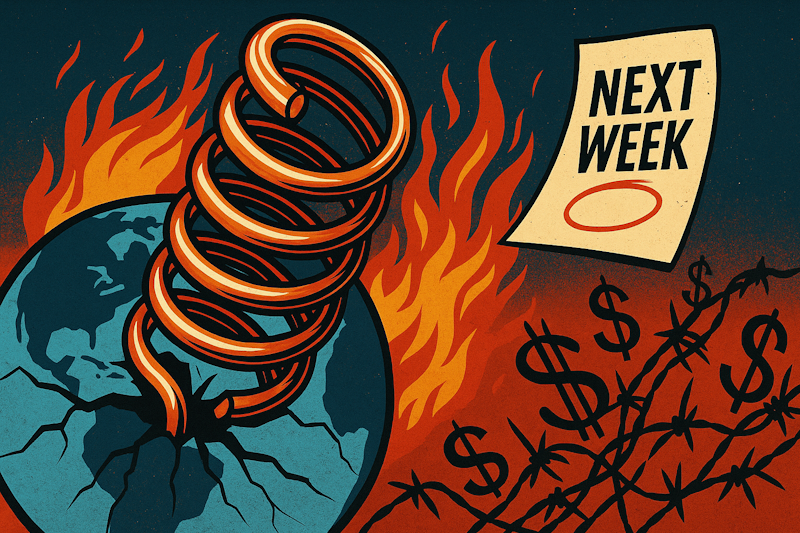Here we go again.
In 2008, to stave off the worst effects of the Great Financial Crises, the Federal Reserve doubled the supply of dollars from $800 billion to over $1.6 trillion.
To keep the lights on over the next decade, that supply doubled again in spurts to $3.2 trillion.
COVID-19 stimulus took us to over $6 trillion.
And now that bank runs have put global financial contagion back on deck, we can expect another order of magnitude leap in dollar supply.
Now, it’s worth pointing out the obvious and elegant irony of all this – today’s panic is a direct result of the Fed’s fleeting attempt to undo past bailouts.
But what I hope is finally getting seared into everyone’s brain pan, is the pattern.
Each successive crisis or government imperative doubles the cost of bailing out the economy. And each bailout creates more dependence and fragility. It allows unavoidable risks to fester and grow.
That price is now unsustainable.
Caught Between a Rock and a Rock
The Federal Government finds themselves in the same pickle they were in in 2008.
Don’t issue more debt for the Federal Reserve to buy and we get a deflationary collapse. Do issue more debt and inflation could run out of control.
Only today, they’re staring down more debt, more fragility, way more inflation, and a debt ceiling debate that, all of a sudden, became vastly more acute.
Now, governmental power structures don’t survive deflationary collapses. But they can scapegoat their way through runaway inflation.
It’s a tried-and-true method of maintaining order.
Which brings me to the biggest lesson of all: Yield power over money to any sovereign, and history proves they will abuse it.
Expecting anything different makes as much sense as leaving a bowl of Skittles in the middle of a playground packed with 8-year-olds and hoping to come back in an hour to enjoy some.
It doesn’t happen.
Whether through clipping gold and silver from coins of old or by printing money to bail out banks and sustain excessive spending today, fiat debasement has all the surprise of a full moon.
But I gotta admit, the U.S. has brilliantly managed their power of the purse over the last 70 years. Not to the advantage of savers, mind you. But, on balance, the United States’ exorbitant privilege has worked out well for most Americans.
At least so far.
The secret to that success boils down to one simple fact: Very well-established network effects for the U.S. dollar.
For decades, the dollar dominated nearly all global economic activity. It also fueled the rise of free humanity’s biggest threat.
And here’s how they pulled it off.
The Dollar Networks Burden
The U.S. managed three incredible feats to allow them to debase the U.S. dollar and delay the negative effects of sovereign debasement.
The first was coming out on top after World War II. The Bretton Woods Agreement made the dollar the world’s reserve currency. Next, the petrodollar agreement with the Saudis in 1974 ultimately led to its use as the common denominator in all global trade, not just oil. And finally, our mercantilist policies with China during the 90s and most of this century.
We fueled the rise of the Chinese economy by buying cheap Chinese goods with dollars. The Chinese used those dollars to buy U.S. Treasury debt, effectively lending those dollars back to us so we could keep buying more Chinese goods.
Together, these factors – reserve currency status, petro-dollar payments, and the Chinese mercantilist quid pro quo – conveyed incredible networking effects to the U.S. dollar. This allowed America to export the inflationary effect of debasement to the rest of the world.
But maintaining those network effects come with a heavy price.
We play nice with despots. We overthrow regimes. And we wage war on countries that attempt to exit the dollar network.
All the while, the strong U.S. dollar network makes it easier and cheaper to wage those wars than it would be otherwise. A virtuous cycle from a certain perspective as we barely notice the effects.
But that exorbitant privilege is rapidly coming to an end.
The global economy has split in two. Russia, China, Iran, and Saudi Arabia on one side, the West on the other. And that split cuts the dollar network in half.
Whether Rubles, Yuan, or gold, the dollar’s influence wanes.
Plus, Bitcoin yields an alternate money network far more powerful, and nowhere near as costly to maintain as our current fiat-based system.
And as you can see with this week’s bank bailouts, the costs continue to rise.
Think Free. Be Free.


